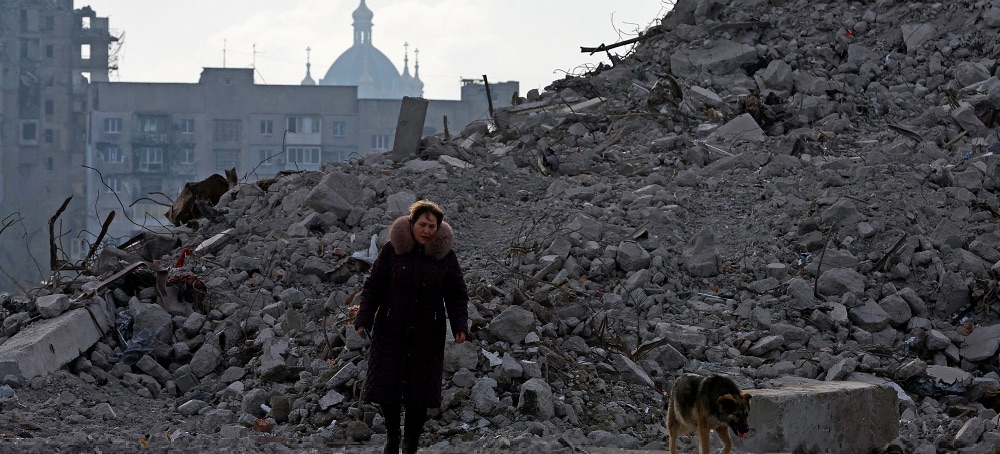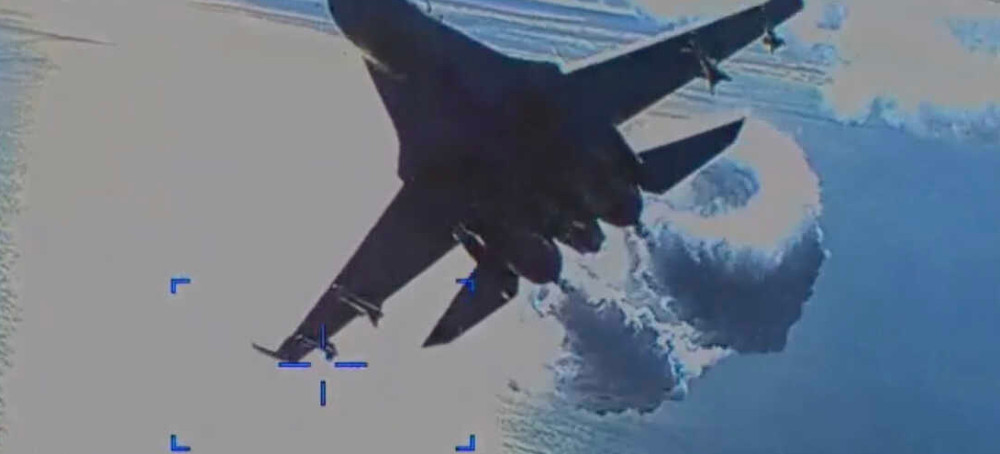Live on the homepage now!
Reader Supported News
The article below is satire. Andy Borowitz is an American comedian and New York Times-bestselling author who satirizes the news for his column, 'The Borowitz Report.'"
The new theme park, tentatively called Dilbert World, will attract “millions of Americans deprived of their favorite comic strip by the left-wing media Reich,” the Florida governor said.
Calling the new tourist destination “a woke-free zone,” DeSantis promised, “Parents who go to Dilbert World can rest assured that their children will not be exposed to the vile multicultural propaganda that it’s a small world, after all.”
DeSantis was vague about what kind of rides might be featured in Dilbert World, saying only that “they will probably involve cubicles.”
READ MORE The invading Russian forces damaged some 90% of residential buildings in Mariupol. (photo: Reuters)
The invading Russian forces damaged some 90% of residential buildings in Mariupol. (photo: Reuters)
Finding people willing to speak to me from Mariupol was never going to be easy.
"I think you are a Russian journalist. You won't like what I've got to say. People like you kill if you tell them the truth," said one social media user who claimed to be from the port city.
Russian forces put the people of Mariupol through a horrific months-long siege, before finally capturing it last May.
I eventually found three residents willing to speak to me at length: a local city councillor, a retired pensioner and an engineer. All spoke on condition of anonymity, fearing reprisals from the local authorities installed by Russia (who block access to occupied Ukraine by Western journalists).
They paint a picture of a massively expensive campaign conducted by Russia to win over the hearts and minds of the people of Mariupol, and rebuild a city damaged beyond recognition by Russia's own troops.
The purpose of this campaign is to assimilate Mariupol and make it Russia's own.
Their accounts corroborate each other, and are confirmed by social media posts about recent developments in Mariupol.
Before this war began about half a million people lived in the city.
According to UN estimates, 90% of residential buildings were damaged or destroyed, and 350,000 people were forced to leave after Russia attacked in February 2022.
It is difficult to estimate the exact number of people killed as a result of the relentless shelling of Mariupol, but Ukrainian authorities say more than 20,000 died there.
Russian-installed authorities in Mariupol say some 300,000 people are now living there.
The people who spoke to me from Mariupol said their city had been inundated with labourers from across Russia, as well as from Central Asia.
Oleg Morgun, the Russia-installed "mayor" of Mariupol, says some 70,000 of those currently in the city are construction workers and members of the Russian military.
Rebuilding
New buildings have appeared and many buildings damaged during the bombardment have gone.
For example, the Russian military has built a whole new district comprised of a dozen apartment blocks in the western part of Mariupol. It is called Nevsky, after the River Neva, on which President Vladimir Putin's home city of St Petersburg stands. According to Russian state media, St Petersburg is the main sponsor of the reconstruction of Mariupol.
"It says on the bus: St Petersburg and Mariupol are twinned cities. There are slogans everywhere telling us that we're part of Russia now," pensioner Maria (not her real name) told me.
"I liked things the way they used to be. Now we live in fear. We have no idea what to expect."
In the houses that escaped relatively unscathed after months of fierce fighting, the Russians are replacing windows, radiators and sometimes heating and sewage pipes.
Heating, running water and electricity supplies have largely been restored. Buses are running and full of passengers again, although the electric trolley bus and tram networks are still out of action.
Many schools, hospitals and shops have reopened as well, although numerous traders are selling their wares straight from the pavement.
Maria was particularly impressed with one school rebuilt under Russian rule: "It's so beautiful, covered in multi-coloured squares." According to her, the number of children in Mariupol now is greater than schools can currently accommodate, so they have classes in two shifts: one in the morning, and another in the afternoon.
Russia has imposed its own Russian-language curriculum in occupied areas - complicating efforts to get children back to school.
The fast-paced rebuilding of Mariupol has provoked envy in Donetsk, the regional capital occupied by pro-Russian forces since 2014, which has been neglected by comparison.
The Russia-installed head of the so-called Donetsk People's Republic, Denis Pushilin, has even had to deny rumours that the capital will be moved to Mariupol.
Assimilation
There are other important ways in which Russia is putting its stamp on Mariupol.
For example, local residents are under pressure to obtain Russian passports.
Ivan, the Mariupol city councillor I spoke to (not his real name), said locals often formed "huge queues" trying to get Russian passports.
They were required if you want to find formal employment, especially with government agencies or in the public sector, he explained.
Also, they made it possible to travel to Russia without additional stringent checks known as "filtration", he added.
"So they have deliberately created a situation where you get problems if you have Ukrainian papers, you have to deal with red tape, you have to wait. On the other hand, if you get a Russian passport, that's where your problems end: 'You're one of us now'. Things get simpler if you receive a Russian passport," Ivan said.
Mariupol is also becoming part of Russia's financial system. The Ukrainian currency, the hryvnya, has been phased out, and now the Russian rouble is the only currency accepted in shops.
Russia is channelling huge amounts of money into pension payments for residents of Mariupol, raising them in many cases compared with what they received from the Ukrainian authorities before the war. So residents of Mariupol are able to draw two pensions - one from Russia, another from Ukraine. Naturally, it is a situation many local pensioners are happy with.
Russian pensions are another reason why elderly residents are queuing up to get Russian passports - many pensioners believe the documents will be required in the future to continue receiving payments from Russia.
The media currently operating in Mariupol are also hard at work promoting a uniformly pro-Russian agenda.
Pro-Russian sentiment
Many current residents of Mariupol are there because they were unable to leave the city when the Russians attacked, due to illness or old age, or because they welcome Russia's presence.
"We've suffered enough under Ukraine. Now we can breathe again," one social media user told me, before breaking off all contact.
The fast-paced campaign of reconstruction and the resulting sense of restored normality, the generous pension payments and the intensive media campaign targeting the people of Mariupol, all stimulate the spread of pro-Russian sentiment in the city.
"I'm sick of all the propaganda in the papers. They started publishing it from day one, telling us how well things are going," said Yuri, the engineer (not his real name). "I feel out of place in my own city now. People are different, my city feels different now."
City councillor Ivan said: "It's become difficult for me to say pro-Ukrainian things to my voters. It's tough being pro-Ukrainian in a pro-Russian environment. Unfortunately, Ukraine is losing the hearts and minds of people in Mariupol."
Those who are still in Mariupol may be happy to see a degree of normality return to their city, but there are those who suspect Russia of pursuing ulterior motives.
Popular Ukrainian journalist Denys Kazansky argues that Russia uses the new houses it has been building in Mariupol to distract attention from all the destruction it caused in the city and elsewhere in his native Donetsk region.
"If they destroyed 10 hospitals and then rebuilt one - this isn't reconstruction. It's not something they can be thanked for," he said.
"You can be happy as much as you like about a school being rebuilt, but what do you do with the thousands of people Russia has killed?" he said.
"You can't rebuild them. You can't bring them back."
READ MORE  A Russian Su-27 fighter jet releases fuel as it approaches the rear of a U.S. Air Force MQ-9, in what the Pentagon says was 'an unsafe and unprofessional intercept' over the Black Sea. (photo: U.S. European Command video/NPR Screenshot)
A Russian Su-27 fighter jet releases fuel as it approaches the rear of a U.S. Air Force MQ-9, in what the Pentagon says was 'an unsafe and unprofessional intercept' over the Black Sea. (photo: U.S. European Command video/NPR Screenshot)
The release of the video comes two days after the Pentagon said a Russian Su-27 fighter clipped the propeller of an uncrewed MQ-9 Reaper drone that was operating in international airspace, forcing it down into the water. The Kremlin says its jets did not make contact with the drone.
The footage gives brief glimpses of the encounter, which U.S. officials say lasted for at least a half hour. The Pentagon says the video depicts events in the order they happened, although it was edited to condense the action.
In the 42-second video, a Russian Su-27 aircraft is seen approaching from the drone's rear quarter, releasing a plume of fuel as it pulls upward and over the drone, causing the footage to partially pixelate. The camera recovers as the fighter jet pulls away, showing the drone's rear-mounted propeller in normal working condition.
The footage then shows what the Pentagon says is an "even closer" pass from a Russian jet.
Approaching from what looks to be a lower angle, the Su-27 releases more fuel and its fuselage is seen coming extremely close to the drone before the video cuts out entirely. The Pentagon says the camera feed was lost for around 60 seconds.
When the feed returns, the camera, which is mounted beneath the MQ-9, pivots to show the drone's propeller has been partially mangled.
Shortly afterward, the aircraft crashed into the Black Sea off the southern coast of Ukraine — a country that the U.S. and dozens of other countries are supporting in its war against Russia. The U.S. has been monitoring movements by Russian troops and warships in the area.
The U.S. European Command described the encounter as "an unsafe and unprofessional intercept."
Speaking to reporters on Wednesday, U.S. Army Gen. Mark Milley said he wasn't sure whether the Russian jet had intentionally made contact with the U.S. drone.
"Was it intentional or not? Don't know yet. We know the intercept was intentional. We know the aggressive behavior was intentional. We also know it was very unprofessional," he said.
Russia's Defense Ministry insists that its fighter jets did not attack or come into contact with the drone, alleging that the U.S. craft lost stability and control as a result of "quick maneuvering," before losing altitude and crashing into the Black Sea.
As for whether the U.S. will seek to recover the downed drone, Milley said on Wednesday that the aircraft crashed in waters that are 4,000 or 5,000 feet deep, making any recovery operation difficult. But he also said the Pentagon is looking at options — which would include its allies, he said, because the U.S. doesn't have "any naval surface vessels in the Black Sea at this time."
Russia says it is looking for the drone.
Defense Secretary Lloyd Austin says the U.S. military "will continue to fly and to operate wherever international law allows." Austin, who spoke with his Russian counterpart, Sergei Shoigu, by phone after the incident, said it's also important to maintain communications, adding, "that will help to prevent miscalculations going forward."
READ MORE  A Polish Air Force MiG-29 aircraft fires flares during a performance at the Radom Air Show at an airport in Radom, August 24, 2013. (photo: Kacper Pempel/Reuters)
A Polish Air Force MiG-29 aircraft fires flares during a performance at the Radom Air Show at an airport in Radom, August 24, 2013. (photo: Kacper Pempel/Reuters)
The planes are in “full working order” and will be delivered in “the next few days,” Duda said at a news conference in Warsaw alongside his Czech counterpart, Petr Pavel. The delivery would mark the first time any of Ukraine’s NATO allies have delivered jets.
“We are literally sending these MiGs to Ukraine at this moment,” he said.
Poland is in the process of upgrading its air force with South Korean-made FA-50 fighters and American-made F-35s, as it rapidly expands its military amid the war in neighboring Ukraine. It has about a dozen of the MiG-29s available that are “mostly” functional, Duda said, adding that the remainder will be “serviced and prepared” before also being donated.
Poland has played a leading role in getting taboo-breaking weaponry to Ukraine. As Germany stalled on sending tanks this year, Duda announced that Poland had decided to send them. Polish officials said it was part of a strategy to ramp up public pressure on Germany to approve the delivery of the German-made tanks.
Ukraine has been pushing hard in recent months for Western countries to donate fighter jets, with President Volodymyr Zelensky dubbing them “wings for freedom.” Poland and Slovakia, which has also said it is ready to send its Soviet-era jets to Ukraine, have called on other countries to do the same as part of an international coalition.
Ukraine already has its own MiG-29s, meaning that Ukrainian pilots will be able to fly them without additional training, Duda said.
In February, Britain announced that it would begin training Ukrainian pilots on fighter jets used by NATO. Both British Prime Minister Rishi Sunak and French President Emmanuel Macron have said they have not ruled out contributing fighter jets to Ukraine, but they suggested that nothing would be immediate.
READ MORE Activists marched through the streets of Atlanta on 11 March to protest the construction of the 'Cop City' training facility. (photo: Steve Eberhardt/Shutterstock)
Activists marched through the streets of Atlanta on 11 March to protest the construction of the 'Cop City' training facility. (photo: Steve Eberhardt/Shutterstock)
Police swarmed camp on Saturday, detained activists and confiscated property; one person arrested, for a traffic ticket
The resident, who asked for anonymity in order to speak with the Guardian, decided to go to a nearby friend’s house. Others were not so lucky. Several dozen other people, including members of a medical crew, were then rousted from campsites on the resident’s property during a post-dawn police raid that followed.
Up to 40 Atlanta police department officers swarmed the sprawling, hillside property, slashing medical supply tents, breaking windows of a camper van parked on site and ripping netting surrounding a greenhouse.
The Guardian has obtained a copy of the search warrant used for the raid and spoke to numerous people present during the police action. The document and the witness accounts offer telling insight into how law enforcement officials and the justice system in Georgia are prosecuting unprecedented state domestic terrorism charges against members of a broad social movement that opposes a $90m police and fire department training center, known as “Cop City”, planned for the nearby South River forest. The movement has also opposed a former film studio owner’s plans to convert 40 acres (16 hectares) of public park in the forest into private property, calling for the forest to be preserved.
The warrant states there was probable cause for believing that evidence of “conspiracy to commit domestic terrorism” could be found at the Lakewood location.
Objects officers sought included “cameras, radios … boxes of nails … lighters … tents, camping equipment, spray paint cans, [and] black clothing”, according to the warrant. The list also mentions “literature … related to defend the forest”. Although several dozen people were detained near the property for several hours, the only person arrested was Mark Lindsey, another year-round resident – for an unpaid traffic ticket. None of the half-dozen people present during the raid and interviewed by the Guardian had any items seized by police, or had heard of anyone else’s property being seized.
But the document’s language follows “what has become a playbook for how counter-terrorism agencies respond to protests”, said Will Potter, who has researched federal terrorism charges against environmental activists in his book Green Is the New Red: An Insider’s Account of a Social Movement Under Siege.
“In a few lines, it conflates the specter of violence with everyday items and basic organizing materials,” Potter said.
The raid was the latest escalation in the show of police force during a recent “week of action” by protesters highlighting the forest’s plight that ended on Sunday, after more than a hundred of the event’s attendees crossed from the public park on to Cop City land on the event’s second day, burning bulldozers and other construction equipment.
Twenty-three people were then arrested and charged with domestic terrorism under Georgia law despite the fact the arrest warrants showed no evidence linking arrestees to acts such as property destruction at the construction site. The same evidence is repeated on all 23 warrants and included defendants having “muddy clothing” – an observation that could apply to the hundreds who were at a music festival in the public park.
In the following days, several peaceful marches took place in Atlanta, as well as camping, a Jewish sabbath service, herbal and foraging workshops – and the scattering of Manuel Paez Terán’s ashes, who police shot and killed on 18 January while the activist, known as “Tortuguita”, camped in the public park in protest against Cop City.
The raided property’s 10 acres, with its towering oaks and pines, had been used in recent years for free food distribution and art and music events. A handful of people live there year-round, but the land had been used for the last week by medical personnel and people camping in tents. According to several people who helped set up the arrangement and spoke to the Guardian, the area was being used to provide a place to camp for families, people with limited mobility and anyone who didn’t feel safe staying at the forest.
The search warrant underpinning Saturday’s raid can be seen as the state “trying to build a conspiracy case, similar to Rico cases”, said Marlon Kautz, an organizer with the Atlanta Solidarity Fund, which provides bail and other resources to protesters who have been arrested.
“It gives them the legal framework to go after organizers, [who are] seen as leaders – even though they haven’t done anything criminal.”
The innocuous items police sought according to the warrant also bring to mind raids on other political movements, Kautz said. “You can look at how many of these are household items,” he said. “It’s like you find a can of gas sitting next to a lawnmower, and say you’ve found evidence of bombs.”
The protest movement is broad-based. It includes local preschool families, Black faith leaders from Atlanta, local and national environmental groups, scientists, Native land and water defenders, and young people from across the US. Nonetheless, Kautz said, “investigators are convinced there’s an organized campaign to do terrorism – but so far, they’re not finding any, because it doesn’t exist. So instead, they go after any organizational infrastructure they can find.”
A certain amount of infrastructure, as well as personal items – including medical supplies at the property that were used by a rotating team of healthcare professionals – were destroyed during the raid.
Ric Simmons, a law professor at the Moritz College of Law at Ohio State University, said there’s a legal notion of “reasonability” that law enforcement must use when it comes to handling property while carrying out a court-ordered search. “This destruction doesn’t seem at all reasonable,” he said.
The medical team at the property included Sea, who has a counseling degree and helped with any mental health needs during the week’s events. Others contributed items such as sunscreen and Covid tests and masks. Sea was in their tent on Saturday morning trying to get some rest after a late-night shift when the sounds of police shouting orders and marching feet drove them out of their tent.
About 20 police officers were pointing guns at three members of the medical team, Sea said. “There was a lot of yelling. It was disorienting.” Some of the police stayed at the property, while others led Sea and a group of about 20 several blocks away to wait. During that time, police asked the detainees for ID and took their photos. The police eventually let them go.
Sea returned just before dusk to find the medical team’s tents slashed and some of the supplies destroyed. A colleague who preferred to remain anonymous and was also at the site of the raid said they “felt fear … but I know that this is how many people feel every day, just living their lives. If Cop City gets built, this fear and destruction … will only become more commonplace.”
Will Potter has interviewed people who have participated in political movements during the last four decades and undergone similar raids. “It’s a heavy-handed show of force, a destruction of property … It’s police trying to make you violated, and afraid.”
Potter called attention to the warrant’s reference to “literature”.
“This stands out to me,” he said. “It brings up freedom of speech and association concerns. If I were raided, my bookshelf doesn’t look so good.”
READ MORE  Georgia grand jury foreperson 'not positive' about Trump claims of 'total exoneration.' (photo: Alyssa Pointer)
Georgia grand jury foreperson 'not positive' about Trump claims of 'total exoneration.' (photo: Alyssa Pointer)
Ex-president’s calls to state officials could lead to unprecedented criminal charges
Ralston, who has since passed away, reportedly deflected the outgoing president’s request, allegedly telling Mr Trump, “I will do everything in my power that I think is appropriate,” according to jurors who spoke with the Atlanta Journal-Constitution, which first reported the news of the call.
A special session was never called, though Republicans in the state did organise a plan to serve as unauthorised fake electors and cast their votes in the Electoral College for Donald Trump, even though Mr Biden won the state’s vote.
The Independent has contacted Mr Trump for comment.
The jurors have previously focused on other calls Mr Trump made in 2020 to state officials, including an infamous recording of the president asking Georgia Secretary of State Brad Raffensperger to “find” him enough votes to win.
Since February 2021, Fulton County District Attorney Fani Willis has been investigating the former president’s attempts to influence the state’s 2020 presidential election results.
In January of this year, a grand jury convened by Ms Willis concluded its work, leaving the prosecutor in the unprecedented position of deciding whether Donald Trump will be the first former president in US history to be prosecuted for a criminal offence.
“You’re not going to be shocked. It’s not rocket science,” Emily Kohrs, foreperson of the jury, told the New York Times of its conclusions. “You won’t be too surprised.”
“We definitely started with the first phone call, the call to Secretary Raffensperger that was so publicized,” Ms Kohrs added.
In another recorded call, reported by The Washington Post, Mr Trump can be heard urging Frances Watson, Georgia’s chief election investigator, to uncover “dishonesty.”
“When the right answer comes out, you’ll be praised,” he says in the recording.
READ MORE  One-sixth of U.S. households are in rural communities. The Biden administration wants to help modernize their grids, invest in renewables, and improve the efficiency of their homes. (photo: Brookings Education)
One-sixth of U.S. households are in rural communities. The Biden administration wants to help modernize their grids, invest in renewables, and improve the efficiency of their homes. (photo: Brookings Education)
One-sixth of U.S. households are in rural communities. The Biden administration wants to help modernize their grids, invest in renewables, and improve the efficiency of their homes.
The Department of Energy hopes to address these longstanding challenges by dedicating $315 million toward a sweeping effort to help rural and tribal communities nationwide modernize their electrical grids, invest in renewables, and help residents increase the energy efficiency of their homes.
The initiative, announced last week, is part of the Energy Improvements in Remote and Rural Areas program. The funding is part of a broader effort to allocate more than $1 billion over the next five years to support energy projects in communities of less than 10,000 people. The goal is to promote climate resilience and address rural energy cost burden — defined as the percentage of a household’s income allocated toward energy bills each month — through “replicable energy projects that lower energy costs, improve energy access/resilience, and/or reduce environmental harm.”
“There isn’t one ideal project — we’re casting a wide net,” a senior Energy Department official told Grist. “[Rural] communities are not one-size-fits-all.”
Applications for the funds are due in June, and must include a “community benefits plan” outlining how the project will ensure worker safety, fair wages, and diversity in hiring.
Advocates for rural and tribal communities say the funding does more than facilitate the green energy transition — it facilitates safe, affordable housing. According to a 2018 study by the American Council for an Energy-Efficient Economy, rural households experience a higher energy cost burden than urban households. About a quarter of them occupy poorly insulated mobile homes. Electricity disconnects are high, and storms can knock out power for days. According to the study, even simple household improvements would save the average resident hundreds of dollars every year. Another study found that renewable energy costs consumers less than coal, with 99 percent of coal-fired generation plants costing more to run than wind and solar facilities.
Small utilities and advocates for energy equity say federal investment is sorely needed, particularly in cash-poor, rural areas. Some communities already have pioneered exactly the types of projects encouraged by the federal program announced last week, and hope to secure the funds to launch more.
The Ouachita Electric Cooperative in Arkansas is part of the country’s sprawling rural electric co-op system in which ratepayers are both members and owners of their utility and play a role in decision-making. Based in the small town of Camden, 100 miles south of Little Rock, Ouachita Electric recently embraced renewable energy to better serve its members, who often struggle to make ends meet.
“Our median income is $31,000 — blue-collar factory workers,” said co-op membership manager Leslie Holloway. Some members face an energy burden 30 percent above the national average, she said. Many lack the capital to invest in their homes, most of which are over 30 years old and in dire need of upgrades. Although loans for energy-efficiency upgrades are available to homeowners, they’re often out of reach for rural, working-class renters. To address that, Ouachita secured an $8 million federal grant to kickstart an energy savings program and build a solar array. It used the funding to help improve members’ homes with duct sealing, insulation, and other energy-saving upgrades. Ultimately, the program allowed the cooperative to reduce rates 3.4 percent and saved Ouachita Electric enough money to recoup almost all of its investment.
Rural utilities and power companies that are working toward a green transition say half the work lies in overcoming decades of economic disadvantage and disinvestment. Brett Isaac, the founder and executive chairman of public benefit renewable energy corporation Navajo Power, said public assistance in funding the energy transition is essential for communities that have long been left behind.
“The investment from the various different opportunities under the Biden administration, from infrastructure to the Inflation Reduction Act … these are all monumental, because they’re actually putting quantifiable investments into certain areas that have never really experienced them,” said Isaac, a 2022 Grist 50 honoree. “We don’t have the institutions that created our economies, like we’re not in control of those things.”
Since its beginning, uranium, coal, and other minerals have been mined on Navajo territory, but nevertheless left most of the people living there in poverty. That era may be passing. The Navajo Generating Station, formerly the largest coal-fired power plant in the country, powered down in 2019, leaving its massive service area in need of both new jobs and new energy resources. Almost 30 percent of the reservation’s homes still don’t have electricity. But Navajo Power is currently in phase one of a plan to build utility-scale solar projects on tribal land and install panels on residents’ homes.
In Kentucky, Chris Woolery, a residential energy coordinator with the Mountain Association, can’t wait to help rural power companies and electric cooperatives access the federal funding. Advocates throughout the state have been laying the groundwork for a renewable transition for many years. The Mountain Association, for example, provides loans for small solar projects and works with other groups to push for state policies friendlier to small-scale solar development. “What we are saying is, we know that we have the tools to address our problems. We pioneered them ourselves,” Woolery said.
A big barrier, he said, could be legislative — for instance, state lawmakers are trying to pass a bill banning utilities from accepting federal funds to shut down coal plants. Meanwhile, the outdated grid in central Kentucky left thousands without power for days after a windstorm last month. Woolery said energy efficiency and distributed renewables could increase grid resiliency during extreme weather — a necessity in remote communities where roads can be damaged and emergency services can be hours away. Ultimately, he said, providing energy equity and reliability is a matter of not just savings, but survival — a promise that no one should ever have to choose between their energy bill and their next meal.
“We’re working towards a vision in which access to energy is just a human right,” Woolery said.
Follow us on facebook and twitter!
PO Box 2043 / Citrus Heights, CA 95611



No comments:
Post a Comment
Note: Only a member of this blog may post a comment.